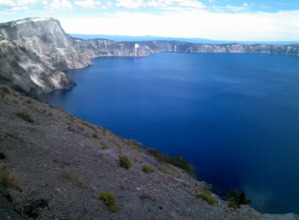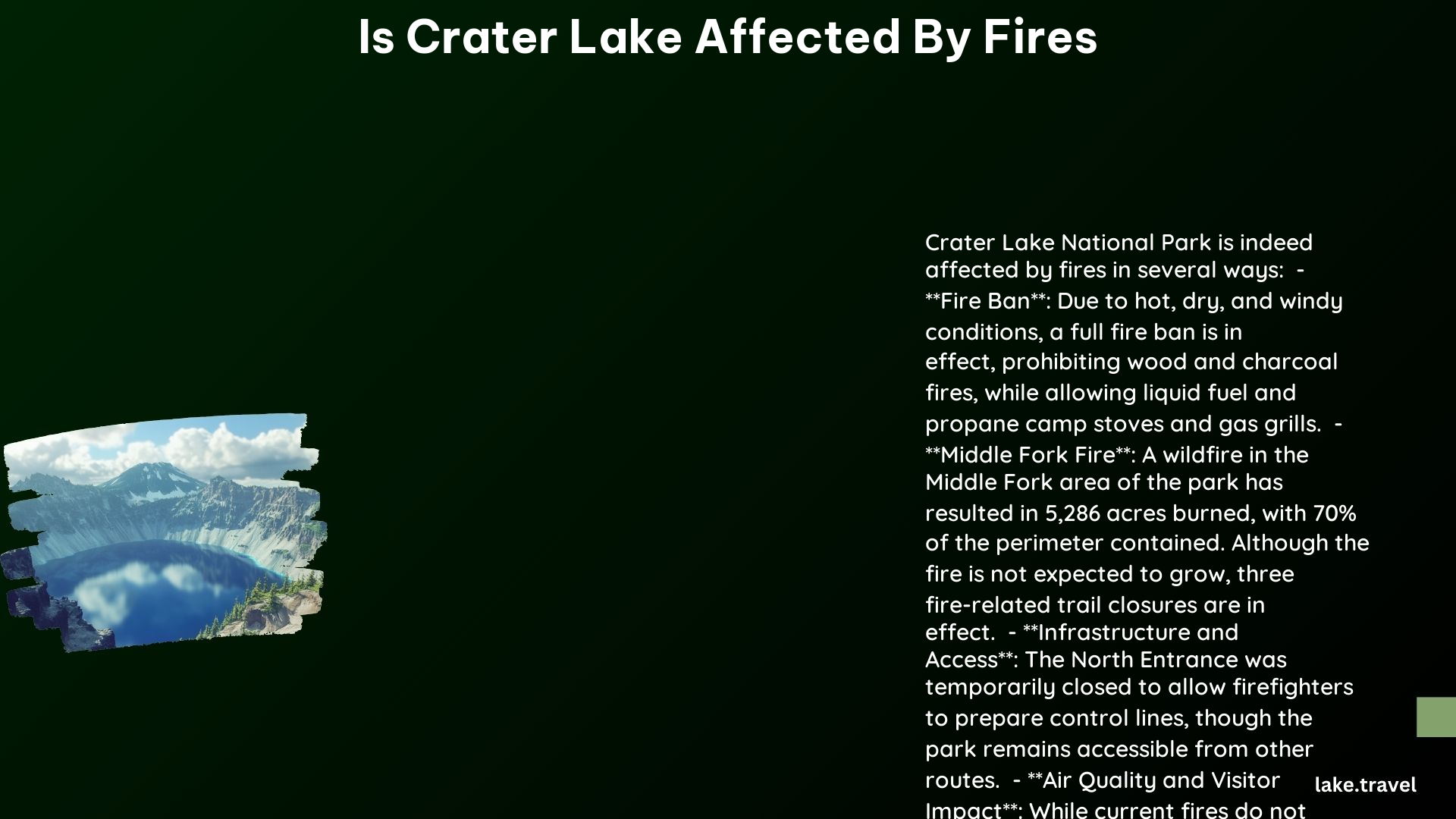Crater Lake, a pristine natural wonder in Oregon, faces significant impacts from wildfires. The area’s ecosystem, wildlife, air quality, and forest health are all affected by increasing fire frequency and severity. Climate change and historical fire suppression have altered the natural fire regime, leading to denser forests and higher fuel loads. This article explores the complex relationship between Crater Lake and wildfires, examining their effects and management strategies.
How Do Wildfires Impact Crater Lake’s Ecosystem?

Wildfires have profound effects on the Crater Lake ecosystem, altering forest structure, wildlife habitats, and overall biodiversity. The impacts include:
- Changes in forest composition
- Shifts in wildlife populations
- Alterations to soil chemistry and structure
- Potential water quality issues in the lake itself
The severity of these impacts depends on various factors, including fire intensity, duration, and the pre-existing conditions of the affected areas.
Forest Structure Changes
The forests surrounding Crater Lake have adapted to a specific fire regime over thousands of years. However, recent changes in fire patterns have led to:
- Increased stand density
- Accumulation of dead and downed wood
- Shifts in tree species composition
These changes make the forest more susceptible to high-severity fires, which can result in long-term alterations to the ecosystem.
Wildlife Habitat Disruption
Wildfires can have both positive and negative effects on wildlife:
| Positive Effects | Negative Effects |
|---|---|
| Creation of new habitats | Destruction of existing habitats |
| Increased food availability for some species | Loss of nesting and denning sites |
| Promotion of habitat diversity | Temporary displacement of animals |
The overall impact on wildlife depends on the fire’s severity and the species’ ability to adapt or relocate.
What Are the Air Quality Concerns During Wildfires Near Crater Lake?

Air quality is a significant concern during wildfire events near Crater Lake. The smoke and particulate matter released can have far-reaching effects:
- Reduced visibility in and around the park
- Health risks for visitors and local residents
- Potential impacts on lake water chemistry through ash deposition
Park authorities often implement air quality monitoring systems during fire events to ensure visitor safety and track long-term impacts on the ecosystem.
How Does Fire Management Affect Crater Lake National Park?
Fire management plays a crucial role in protecting Crater Lake National Park and its surrounding areas. The National Park Service employs various strategies to mitigate fire risks and maintain ecosystem health:
- Prescribed burns
- Mechanical thinning of forests
- Creation of firebreaks
- Ongoing monitoring and research
These management techniques aim to restore natural fire regimes and reduce the risk of catastrophic wildfires.
Prescribed Burns: A Controlled Approach
Prescribed burns are carefully planned and executed fires that serve several purposes:
- Reduce fuel loads in the forest
- Promote native plant species growth
- Create diverse habitats for wildlife
- Mimic natural fire cycles
Park managers conduct these burns under specific weather conditions to ensure control and maximize ecological benefits.
Mechanical Thinning: Reducing Forest Density
Mechanical thinning involves the selective removal of trees and underbrush to:
- Decrease competition among trees
- Reduce fuel loads
- Create more open forest structures
- Improve forest resilience to wildfires
This technique is often used in conjunction with prescribed burns for comprehensive fire management.
What Are the Long-term Effects of Wildfires on Crater Lake’s Ecosystem?
The long-term effects of wildfires on Crater Lake’s ecosystem are complex and varied:
- Soil Composition Changes
- Altered nutrient cycles
- Potential erosion issues
-
Changes in soil microbial communities
-
Vegetation Succession
- Shifts in plant species composition
- Potential for invasive species colonization
-
Long-term changes in forest structure
-
Wildlife Population Dynamics
- Altered habitat availability
- Changes in predator-prey relationships
-
Potential for local extinctions or recolonizations
-
Hydrological Impacts
- Changes in water runoff patterns
- Potential for increased sedimentation in streams and the lake
- Alterations to local water chemistry
These effects can persist for decades, shaping the future of Crater Lake’s ecosystem.
How Do Climate Change and Wildfires Interact at Crater Lake?
Climate change and wildfires form a complex feedback loop at Crater Lake:
- Increased Temperatures
- Longer fire seasons
- Drier forest conditions
-
Greater potential for lightning strikes
-
Altered Precipitation Patterns
- More frequent droughts
-
Changes in snowpack and spring runoff
-
Vegetation Shifts
- Migration of plant species to higher elevations
- Potential for new fire-prone species to establish
These factors combine to create an environment more susceptible to frequent and severe wildfires, posing ongoing challenges for park management.
What Measures Are in Place to Protect Crater Lake from Severe Wildfires?
Crater Lake National Park has implemented several measures to protect the area from severe wildfires:
- Fire Management Plan
- Comprehensive strategy for fire prevention and response
-
Regular updates based on new research and changing conditions
-
Early Detection Systems
- Lookout towers and remote sensing technology
-
Rapid response protocols for fire suppression
-
Public Education Programs
- Visitor awareness campaigns about fire safety
-
Community outreach to promote fire-wise practices
-
Interagency Cooperation
- Collaboration with local, state, and federal agencies
- Shared resources and expertise for fire management
These measures aim to balance ecosystem health with visitor safety and resource protection.
How Can Visitors Help Prevent Wildfires at Crater Lake?
Visitors play a crucial role in preventing wildfires at Crater Lake. Here are some guidelines to follow:
- Obey Fire Restrictions
- Follow all posted fire rules and regulations
-
Be aware of current fire danger levels
-
Proper Disposal of Smoking Materials
- Use designated smoking areas
-
Fully extinguish cigarettes and dispose of them properly
-
Campfire Safety
- Use established fire rings or grills
- Never leave a fire unattended
-
Ensure fires are completely out before leaving
-
Vehicle Maintenance
- Avoid parking on dry grass
-
Ensure proper maintenance to prevent sparks
-
Report Suspicious Activities
- Alert park staff to any signs of smoke or fire
- Report any unsafe fire practices observed
By following these guidelines, visitors can help protect Crater Lake’s unique ecosystem from the devastating effects of wildfires.
In conclusion, while Crater Lake is indeed affected by fires, ongoing management efforts and visitor cooperation play crucial roles in mitigating these impacts and preserving this natural wonder for future generations.
References:
1. Mixed Severity Fire Regimes & Forest Structure at Crater Lake
2. Coming Full Circle: How Parks Are Using Conventional Tools in New Ways to Restore Imperiled Forests
3. Fire FAQs—Have the size and severity of forest wildfires increased in Oregon and across the West?
